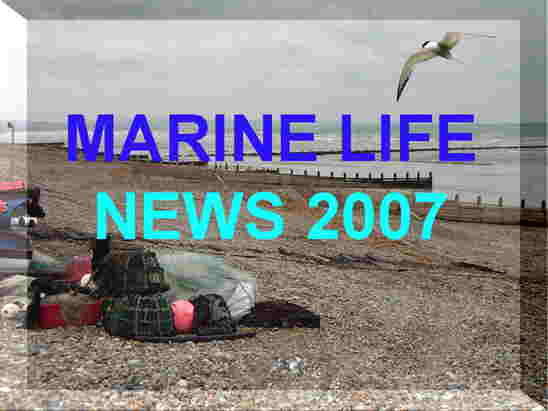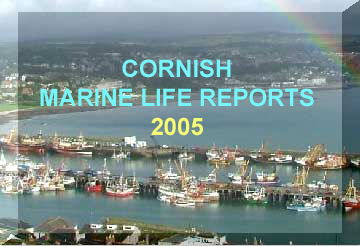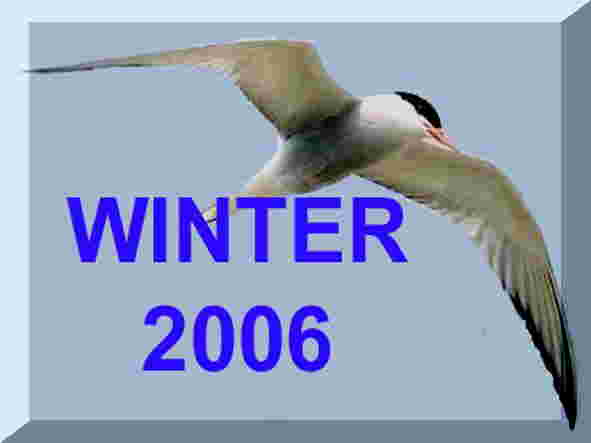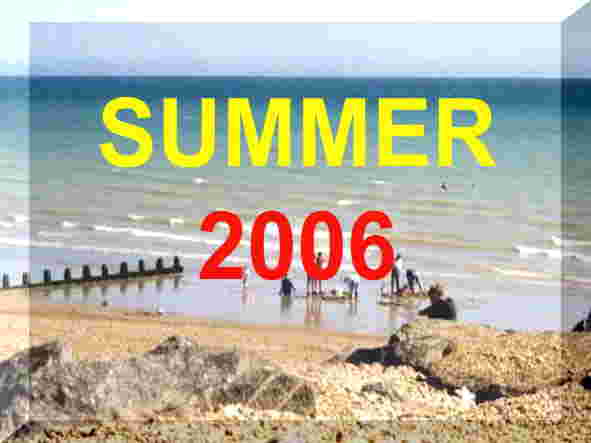LATEST
NEWS:
14
December 2006
At
Sennen,
Cornwall, two species of Violet Sea-snails,
Janthina
janthina and Janthina
pallida, as well as two sea
beans Entada gigas
and Caesalpina bondoc
were discovered on the strandline.
BMLSS
Beachcombing
1 -
9 December 2006
The
prevailing winds of autumn and the recent gales have washed more unusual
pelagic animals on to the shore (with the millions
of By-the-wind Sailors, Velella velella,
and multiple thousands of Goose Barnacles,
Lepas
anatifera) notably the small (size
of a 10 pence piece) pelagic Columbus Crabs,
Planes
minutus, with five discovered on the Dorset
coast at Southbourne (near Bournemouth)
and a further 15 at Hengistbury
Head, Dorset. The latter was discovered inside a large shipworm-riddled,
Teredo,
pole in cavities created by the tiny burrowing mollusc.
The Columbus Crabs were
found with the Goose Barnacles
and there are clues that the buoys, wooden pallets, fish boxes etc. have
been floating around the Atlantic Ocean for two years or more and are American
in origin. The live crabs were placed in the aquarium at the Foundation
Marine Centre at Kimmeridge.
Previous
Report from the Channel Islands
Previous
Report from Belgium
2 December
2006
My
dog discovered a strange fish partially buried on the North
Gare Sands, Hartlepool, (near the power station) part of the Teesmouth
National Nature Reserve; the fish was one metre long, 30 cms wide and
laterally very thin with a tapering tail. I have identified this fish as
a Deal Fish,
Trachipterus
arcticus.
The Deal
Fish is a deep sea fish which very occasionally
is washed up on the shore.
Previous
Report
November
2006
At
least two specimens of the large pelagic swimming crab known as Henslow's
Swimming Crab, Polybius henslowii, were
brought in by a commerical fishman from Poole Bay. This
crab is an active predator of small fish and is usually found over deep
water further south. The same weather conditions which have brought in
the By-the-wind Sailors are
likely to have blown this crab into the shallow bay.
BMLSS Crabs
26
November 2006

Thousands
of By-the-wind
Sailors, Velella velella, were washed
up on Welsh beaches, notably a narrow but continuous line of Velella
velella washed up on the high tide mark at Borthwen,
Rhoscolyn, Anglesey (southern end of Ynys Cybi - Holy Island), north
Wales (Ian
Wright); literally thousands stranded
on a small bay at the Mumbles, Swansea (Jess
Pitman); a swarm amounting to about two
hundred were washed up on Porthllysgi beach off the coast of St.
Davids in south west Wales (Eleri
Davies) with hundreds, possibly thousands,
stranded and dead on the pebbles on the nearby Newgale Beach (Helen
Lee); thousands, if not millions, of By-the-wind
Sailors were washed up on a beach at Criccieth
(on the southern coast of the Lleyn Peninsula), Gwynedd, north Wales (Eilir
Daniels); and an armada, a thick layer
of jellyfish about a metre thick on the strandline in both directions at
Cefn
Sidan Beach at Pembrey, south west Wales (Bella).
BMLSS
Velella
19
November 2006
An
extraordinary report of an Oceanic Pufferfish,
Lagocephalus
lagocephalus, discovered washed up
dead on the shore by Christopher and Morwenna
Smart at Treyarnon
Bay, near Padstow,
on the north coast of Cornwall.
"At
first I thought it was a plastic toy fish, but then realised it was real
and so we carried it home in an old fishbox we found. It was a really beautiful
fish, blue, silver and white with a green stripe through its eye and quite
different from fish we normally see around here."
There
were also By-the-Wind Sailors, Velella
velella, washed up.
In
the period 31 October 2005 to 8 December
2006 there were seven Oceanic
Pufferfish recorded in Cornwall, compared
to 17 in Cornwall and about 40 in the whole of Britain and Ireland from
about 1760 to 2004. In this same 13 months there were three found
stranded in Ireland and three caught by French fishermen in Biscay.
This
is the first confirmed report of an Oceanic
Pufferfish, Lagocephalus lagocephalus,
on
these Marine Life News web
pages. There have been unconfirmed
reports of live ones seen briefly by divers. This fish is a common
pelagic species of sub-tropical and tropical seas worldwide.
15
September 2006
Fisherman
Geoff
Blake was stunned when he discovered an unusual
30 cm long fish in his regular morning catch off Ventnor,
southern Isle of Wight. The fish was identified*
by
the fishermanas the first ever Lesser Amberjack,
Seriola
fasciata, to be found in British seas.
All four of the Amberjacks
of the North Atlantic Ocean are vagrants in British seas and there are
only 17 confirmed records of the other three species. This fish was caught
in 6 metres of water, just 200 metres from the shore.
(*Identity
to be confirmed. These fish are difficult to identify, sometimes requiring
a count of the gill rakers. Recent fish caught have been the Almaco
Jack, Seriola
rivoliana.)
2004
Amberjack Report
BMLSS
Amberjack Notes
13
September 2006
A
vagrant Atlantic Tripletail,
Lobotes
surinamensis, was caught in a stake
net on
the
banks of the River Severn near Newport. The fish is now in the National
Museum and Galleries of Wales with the Curator
of Vertebrates, Peter Howlett.
This
tropical fish is likely to be the first one ever caught in British seas.
31
August - 1 September 2006
A
pair of Northern Bottle-nosed Whales,
Hyperoodon
ampullatus, were washed up alive on
the Lincolnshire coast (North Sea east coast of England) and despite strenuous
attempts by the British
Divers Marine Life Rescue using pontoons to float the whales, the female
died on the scene, and the male towed 1.2 km out ot sea and seen to swim
away, was found washed up dead at Seacroft,
near Skegness, on the second day.
Previous
Stranding in London
13
- 14 August 2006

Buoy
Barnacles on White Park Bay beach (north
Antrim)
Photograph
by Dave Harrison
Large
numbers of Buoy Barnacles,
Dosima
fascicularis, were found stranded on the
north coast beaches of Northern Ireland, e.g. Portstewart
Strand and White
Park Bay (County Antrim). There were at least six of these batches
seen on the White Park Bay beach during the walk
Buoy
Barnacles are
attached to floats that they had secreted that have a texture like that
of expanding foam.
BMLSS
Barnacles
c.
9 August 2006
A
vagrant 18 kg (40 lb) Big-eyed Tuna,
Thunnus
obesus, was a rare capture by a commercial net fisherman 70 miles off
Land's End and 2,000 miles adrift of its usual habitat in the tropical
Atlantic Ocean. It is only the third capture
on record from British seas.
BMLSS
Tunnies
7 August
2006
Peter
Dent spotted a two metres long
Broad-billed Swordfish,
Xiphias
gladius, (58 lb = 26 kg) thrashing
about in his salmon net a mile off Newbiggin-by-the-Sea
in Northumberland (north-east England). Because of its size and the damage
it was causing the fish had to be killed.

Peter Dent with the Swordfish
Photograph
by Alan Charlton
Northern
Federation of Sea Anglers Society (NFSAS)
This
is the first recent record of a Swordfish
being caught off the British mainland coast, although there have been both
sightings and Swordfish
washed ashore dead this century. This fish
was thought have to have been following the Mackerel
shoals.
BMLSS
Swordfishes
3 -
7 August 2006

Buoy
Barnacles from Connemara
Photograph
by Alison
Thousands
of the stalked Buoy Barnacles,
Dosima
fascicularis, are washed ashore on the
beaches of Connemara, County Galway,
south-west Ireland. They were stranded all
along the west coast of Ireland.
Report
and Photograph by Alison
BMLSS
Barnacles
17
June 2006

Admidst
so much excitement that the camera could be found immediately, a three
metres long (including the sword) Broad-billed
Swordfish,
Xiphias
gladius, swam past our dive boat off
the south coast of Devon, off Teignmouth
(near the wreck of the Galicia).
In
neither case above was the precise species of swordfish
identified, it is assumed from other confirmed records as the most likely
species.
8 June
2006
WORLD
OCEANS DAY
World
Oceans Day was first declared as 8th June at the Earth Summit in Rio de
Janeiro in 1992.
Adur
World Oceans Day
7 June
2006
The
largest* Atlantic Halibut, Hippoglossus
hippoglossus, ever recorded was caught and
landed by professional net fisherman Rolf
Larsen (62 years old), at Stamsund, Lofoten,
Norway (within the Arctic Circle but with seas warmed by the Gulf
Stream). This massive fish weighed 282 kg and would have probably weighed
290 kg when first caught. The difference was because of the loss of blood
after capture. Its total length was 262 cm. The fish was sold for display.
Nettavision
News Report (with a photograph)
(*
My current information has the previous largest as 266 kg and 365 cm long.)
BMLSS
Halibut
BMLSS
Large Halibut
Halibut
(Wikipedia)
28
April 2006
An
extremely interesting report of three Sea
Horses, Hippocampus
hippocampus reported by Southwick
(West Sussex) fishermen; the fishermen say they are the first caught for
several years and other fishermen are reporting them in their fixed nets
several miles offshore. The identity of these
fish has not been verified personally, but Sea
Horses are known to be rarely captured from
the Sussex coast.
Hearsay
Report by Peter Talbot-Elsden
BMLSS
Seahorses
27
April 2006
The
small
crustacean on the right was discovered on
the shore at Eastbourne, Sussex.
This
is Alpheus,
the Snapping Prawn
and not Axius. Note the absence of the triangular
plate that extends to a minor rostrum between the eyes. It is Alpheus
macrocheles, a scarce species found
on the south coast of the British Isles (in British seas).
|
 |
13
April 2006
My
diving work boat Scavenger was engaged in mooring recommissions in the
bay (natural harbour ) named Cove on the South side of St Agnes, in the
Isles of Scilly, when Jolene Allsop,
a professional diver working with me, disturbed a Puffer
Fish at rest in a heavily kelped underwater
marker buoy at about three metre depth and with very good visibility (in
excess of 15 metres). Jo has seen Puffer Fish
before in tropical waters and was able to observe this 15 cm fish long
enough to have no doubt as to it's identity.
The vagrant
Oceanic
Puffer Fish species rarely seen in British
seas is
Lagocephalus
lagocephalus.
14
March 2006

A Deal
Fish, Trachipterus
arcticus, was captured in a trawl
(by
Swedish trawler GG 348) at a depth of 200
metres in the northern Skagerrak off the south coast of Norway. The fish
weighed 12 kg and was measured with a total length of 177 cm. The
photograph above shows Swedish fishmonger Svante
Wedin with the elongate fish.
The
Deal
Fish is a
rare
deep water fish with only a handful of North Sea coast reports of this
fish on record.
26
February 2006
A
two metre long Deal Fish,
Trachipterus
arcticus, was reported caught by 16
year old angler Vibeke Thomasson at
Sørevågen, Utsira, Norway. The full report includes a photograph
showing the red dorsal fin.
Full
Report
Another
1993 Report (in Swedish)
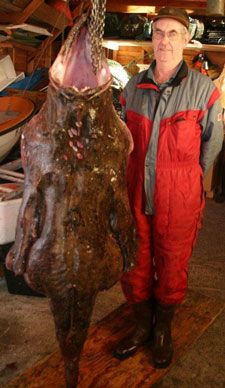 |
21
February 2006
A
new record weight Angler Fish,
Lophius
piscatorius, weighed in at 78 kg with
a total length of 164 cm, was captured in a net by Øystein
Øye, from off Norway.
|
15
February 2006
Another
Sperm
Whale, Physeter catodon,
was spotted near North Shore Road, Skegness
(Lincolnshire) on the North Sea coast during the morning high tide. It
was clear that it was dead after the tide receded.

Head
of the Sperm Whale on Skegness Beach
Photograph
by Karla
Ryder (Wymeswold)
The
Natural
History Museum took photos and limited samples of two dead Sperm
Whales, Physeter catodon,
in the Wash. Paul Jepson
visited the one at Skegness, quite decomposed,
a male, 14 metres in length. This means at least four Sperm
Whales have been washed up on the East Anglian
coast of Britain in February 2006.
BDMLR
Forum Extra Information
Skegness
Humber Whale Report
UK
Cetnet (Yahoo Group)
BMLSS
Cetacea
It is the tenth anniversary
of the Sea Empress Tanker spillage at Milford Haven.
British
Oil Spills
12
February 2006

Bass
with a blunt head
Photograph
by David Wilkinson
This
most extraordinary looking Bass,
Dicentrarchus
labrax, was caught off the coast of Guernsey,
tagged and returned to the sea. Its blunt head looks like that of the Pagrus
Sea Bream and several other fish. This Bass
weighed an estimated 4.5 kg.
4
February 2006
A
ten metre long Sperm Whale, Physeter
catodon, became stranded as
the tide receded on the Humber estuary mud off Kilnsea,
on Spurn Point,
East Yorkshire. It was first spotted alive at about 10:00
am blowing in the shallow water.
It quickly died as it was left clear of water on the low tide at 3:00
pm.
UK
Cetnet (Yahoo Group)
Organisation
Cetacea
BMLSS
Cetacea
21
January 2006
A
Boar
Fish, Capros aper,
is washed up alive on at Branksome
Chine, Dorset (near Bournemouth). It was thrown back in the sea but
it may get washed up again.

This
attractive deep water fish is very occasionally washed up alive or found
in rock pools and very occasionally caught by
anglers.
NB:
Although very tricky to keep and only recommended for advanced
marine aquarists' these fish make fascinating aquarium fish.
BMLSS
Boar Fish
Wet
Thumb (Marine Aquarium Study)
20-21
January 2006
A
four tonne 5.8
metres long immature female Northern
Bottle-nosed Whale,
Hyperoodon
ampullatus, swam up to central London
and was seen as far upstream as Lambeth
Bridge, Westminster, (within sight of the Houses of Parliament). Three
adult whales were spotted east of the Thames Barrier the day before and
at 8:30 am a
man on a train spotted a whale in the Thames out of the train window. Rescue
attempts by British Divers
Marine Life Rescue and the authorities are being directed to persuading
the whale to reverse direction and swim back out to sea and to avoid any
further collisions with boats. This is the first time a whale had been
seen so far upstream since records began in 1913.
On
the second day,
the whale looked in a poor condition and showed no sign of returning to
the open sea. A decision was taken (by
the BDLMR and authorities) to make an improvised pontoon,
crane the whale on to it and tow the unfortunate sea mammal back out to
the Thames estuary. The prognosis was poor. The
whale died at 7:00
pm.
BDMLR
Report & Chronology
BDMLR
Forum
BMLSS
Cetacean Reports 2006
BMLSS
Strandings Page (What to do if you discover a stranded cetacean?)
16-17
January 2006
Twenty
four egg cases of the endangered
Skate, Dipturus
(=Raja)
batis,
were discovered on the shore near the Dounreay
nuclear power plant, Caithness, west of Thurso and Scrabster
Harbour and John
o'Groats on the northernmost coast of mainland Scotland, the first
records reported to the Shark
Trust and the first records on the
mainland Scotland since these egg case occurrences have been recorded.
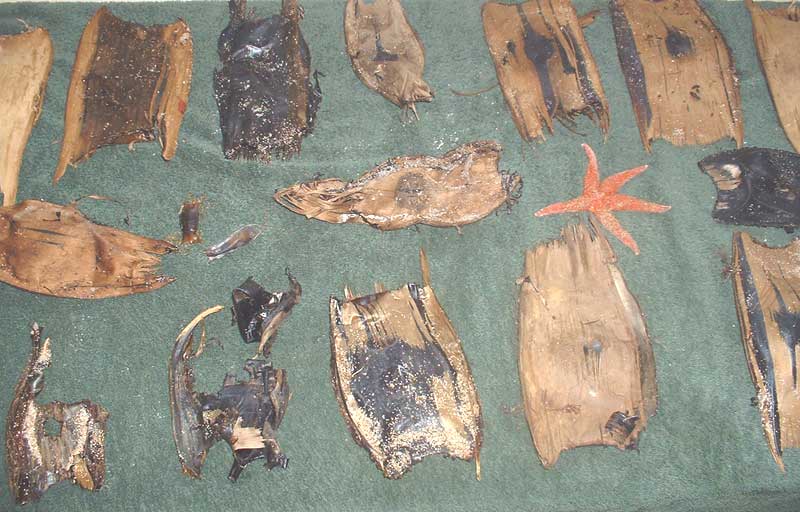
Egg
Cases of the Common Skate
The
egg cases measured between 23 to 28 cm long and 13 to 16 cm wide in a dried
state.
Report
by Paula Gent with photographs
by Davey Benson
 Egg
Capsules of Rays & Sharks (Link to the Web Pages)
Egg
Capsules of Rays & Sharks (Link to the Web Pages)
BMLSS
Mermaid's Purses
January
2005 Report
6
-30 January 2006
A
friendly Bottle-nosed Dolphin, Tursiops
truncatus, visited Maryport
Harbour, Cumbria, on the Solway estuary in north-west England. Fishermen
say the dolphin, nicknamed Marra, has been following them off Workington
since summer and has always been on its own. Experts believe he may have
followed fishing boats into the harbour. It has stayed around in the harbour
for the month of January,
but although it is feeding, there are fears that there is insufficient
food of live fish in the harbour to sustain a large mammal. On 30
January 2006, it was captured and released
into the open sea.
Sea
Watch Foundation News
Magic
Map now has a Coastal and Marine Resource Atlas
Cornish
Marine Wildlife 2005 (Ray Dennis Records)


